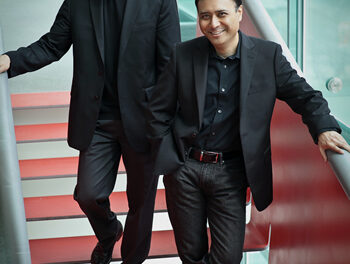A sellout crowd greeted the eagerly-anticipated Kalichstein-Laredo-Robinson Piano Trio’s October 29 concert in Watson Chamber Music Hall on the NC School of the Arts campus. There were multiple connections with the NCSA. Pianist Joseph Kalichstein taught on the campus, and cellist Sharon Robinson is an alumna. Violinist Jaime Laredo is married to the cellist. The sponsors of the Trio’s residency were Judy and Bill Watson, for whom the intimate and acoustically-wonderful hall is named. The program was refreshingly innovative.
Unlike Mozart’s earliest trios, in which the cello is treated only as a continuo instrument, the Piano Trio in B-flat, K.502, gives greater independence to all three parts. The K-L-R Trio gave a flawlessly-balanced reading with marvelous, crystal-clear pianism, brilliant execution of the showy violin part, and full, warm tone in all of the cello’s melodies. The ensemble brought out the vocal-like exchanges between instruments.
It was fascinating to hear the Adagio of Mozart’s Piano Sonata in F, K.280, refracted through the “musical kaleidoscope” of Arvo Pärt! The K-L-R Trio commissioned the piece from the Estonian composer in 1992. From the stage, Kalichstein recounted that Pärt originally called the score a “transcription” but that in his latest revision he refers to is as a “meditation” on the Mozart. Significant silences and enhancements of Mozart’s dissonances are just some of the curiosities revealed.
Several ensembles have gotten early starts on the Shostakovich centenary. CVNC has already covered three performances of the great Second Piano Trio this fall and two of the lesser-known First Trio. Triple Helix did both trios over two concerts in the Triangle. ECU’s Four Seasons Chamber Music Festival and NCSA’s own faculty have done the Second Trio.
Shostakovich’s youthful Piano Trio No. 1 in c Minor, Op. 8 (1928), was pieced together from fragments found among his papers after his death. Even at this early stage, the 18th-year old composer already was using major elements of what became his mature style – the juxtaposition of the grotesque or sardonic with brooding or tender passages. The K-L-R Trio made the strongest possible case for this 13-minute piece.
Along with Ravel’s, Shostakovich’s Piano Trio No. 2 in e minor, Op. 67 (1944), is one of the greatest trios of the 20th century. On the surface, the horrors of Nazi atrocities haunt the work, but the hidden subtext is the atrocities of Stalinism. The crucial opening featured cellist Robinson playing razor-sharp high harmonics on muted strings before violinist Laredo joined with muted strings in the low register, followed by Kalichstein’s cold, stark and low piano chords. A few slips aside, string intonation was excellent as the players slashed through harsh, raw, and sardonic passages that alternate with folk-like melodies. The swirling and lurching second movement came off well. The artists conjured up a desolate dirge in the largo third movement, a chaconne consisting of a set of variations on the eight ominous chords hammered by the pianist alone at the opening. Reports of Nazis making their victims dance on their own graves inspired the frenetic last movement, which is dominated by Yiddish-like dance rhythms.
Hearty and prolonged audience response was rewarded with two encores. Kalichstein’s ability to play clearly at unusually fast tempos was on full display in the rousing “Rondo all’Ongarese: Presto” (“Gypsy Rondo”) from Haydn’s Trio in G, H.15/25. He then apologized for having missed Watson Hall’s birthday before offering a delightful, unfamiliar trio arrangement of “Summertime” from George Gershwin’s opera Porgy and Bess, dedicated to the Watsons.











